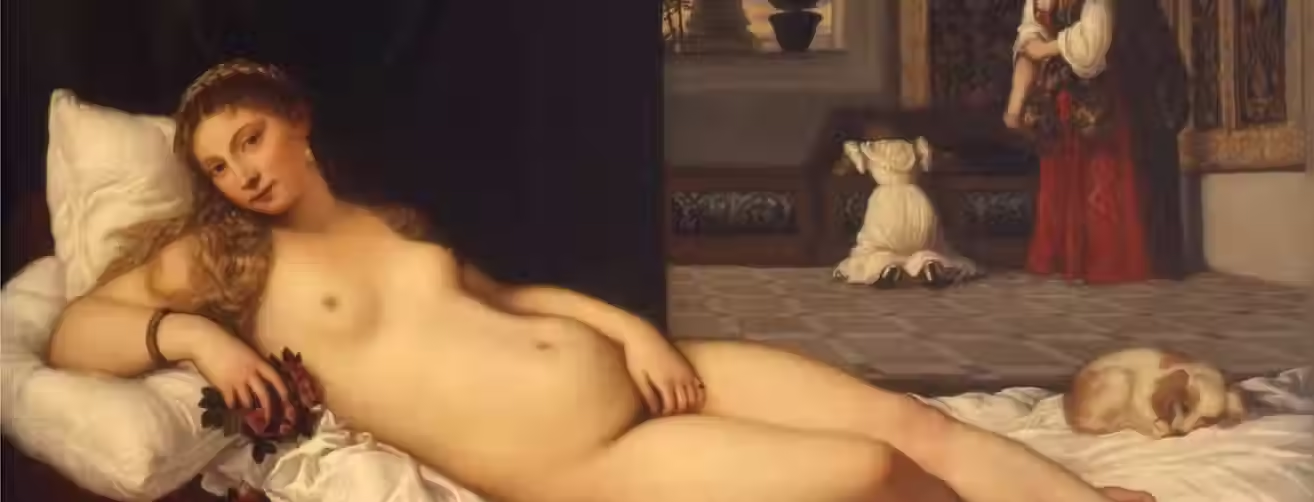VOL. II
THE WINTER SPECIAL
Sleeping King Cavalier Spaniel in
The Venus of Urbino (1534).
Your spaniel may be a Renaissance muse.
The world rests with the sight of a sleeping dog. There is a reason why a painted portrait stands out all the more with the small inclusion of a pet, a detail which humanises, softens.Visible in the Uffizi Gallery in Florence, Italy, The Venus of Urbino gazes at the onlooker, a toy king cavalier spaniel is curled asleep by her feet. Venus is the focal subject of the portrait, a Venetian bride, the image of Giulia da Varano, wife of Guidobaldo II della Rovere di Urbino. He commissioned the work from the master painter, Titian, as a commemoration of their matrimony and a message of what his bride should be to him- an alluring muse, but symbol of devotion. This depiction was a radical choice, one questionable for the times and telling of the man who commissioned it.
In the 1500s Titian (or Tiziano Vecellio) was the official painter of the Republic of Venice, having studied under Giorgione, where he explored the range of what quality colour rendering could transform in an image. He completed Giorgione’s portrait of the Sleeping Venus in 1510, an image and pose which he’d continue in his work with The Venus of Urbino, received as scandalous as its setting directly in the boudoir would be too intimate. Titian’s technique of chiaroscuro, a kind of colour grading which would bring out shadows and play on light, would bring out ethereal forms in the symbols he scattered through the portraits, even those outside of the focal points of his portraits. The tiny cavalier spaniel has a real, dimensional characteristic to it, like it has its own personality. First there’s Giulia’s gaze, then the eye is drawn to the curled up spaniel.
The sixteenth century birth of new ideologies on arts and humanities introduced an ostentatious desire among the new high merchant class to display intellect and at the very least the illusion of grandeur, as an understanding of refinement, through decoration. This was a time with the best paints, the time and money to create detailed dreamscapes. The commissioned themes are often the same, religious Biblical references combined with Greek mythology featuring pastoral settings, studied proportions and colours, great dimension and expressive depictions of the human form and their various surrounding objects and animals, including hounds, often with equally expressive form.
Dogs were featured in art for years preceding the Renaissance masters, as symbols of defence, divine presence and vulnerability in the Mediaeval period. Larger dogs like greyhounds are often depicted as a part of the background or the context for the desired message of the work in question, devices for power and protection. Where Renaissance dogs join their people as subjects in the context of their portraits, symbols of devotion and protection, but a vulnerable or domestic study. Works featuring pets have subliminal notes of prestige, imagery of elaborate settings with the added presence of a dog as a human sensibility. Not only does the cavalier curled up by Giulia da Varano’s side represent a state of tranquillity, but the quality of Guidobaldo II della Rovere di Urbino’s position in Venetian society. A dog, and not just any dog, a king cavalier spaniel, a rare breed with no fighting demeanour.
image courtesy of Le Gallerie Degli Uffizi © uffizi.it
WATCHLIST:
A DOG'S LIFE
"Who feeds a hungry animal feeds his own soul... We think too much and feel too little" - Charlie Chaplin
Charlie Chaplin's 1918 film, A Dog's Life, was Chaplin's first production for National Pictures. His co-star Mut plays Scraps, a thoroughbred companion who aids Chaplin's famous Tramp character in his acts. Sydney Chaplin, his brother, makes. a cameo in the film as well. A silent film classic, this is the perfect silent for you and your pet to cuddle up to.
WATCHLIST:
A DOG'S LIFE, 1918






